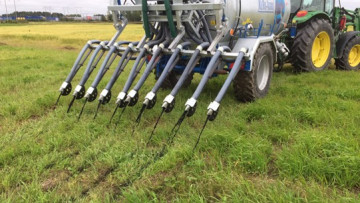Serie R: Overview of microplastics in agriculture settings

Rapporten "Overview of microplastics in agriculture settings" har publicerats i Novias publikationsserie Rapporter 6/2025 i juni 2025.
Abstract
In recent years, the environmental pollution caused by plastics and microplastics has received a lot of attention. Microplastics in agricultural settings primarily reach soil through agricultural practices, organic fertilizers (sewage sludge, digestate or compost), and atmospheric deposition. This report compiles the results of current research about the abundancy of microplastics in agricultural soils after fertilization with sewage sludge and briefly summarized possible effects of microplastics on soil processes, plant growth and soil organisms. Detection of microplastic particles is challenging and some important points from the first test standard for microplastics are highlighted in the report. National and EU regulations on plastic pollution in sewage sludge and digestate from biowaste are also addressed, and measures to reduce microplastic pollution in organic fertilizers are proposed. This report was prepared as part of the Boost Nordic Biogas project, financed by the European Union via Interreg Aurora.
Abstrakt
Under de senaste åren har miljöföroreningarna som orsakas av plast och mikroplaster fått stor uppmärksamhet. Mikroplaster i jordbruksmiljöer når främst marken genom jordbruksmetoder, organiska gödselmedel (avloppsslam, rötrest eller kompost) och atmosfäriskt nedfall. Denna rapport ger en översikt över aktuell forskning om förekomsten av mikroplaster i jordbruksmark efter gödsling med avloppsslam och sammanfattar kortfattat möjliga effekter av mikroplaster på markprocesser, växttillväxt och markorganismer. Detektion av mikroplastpartiklar är utmanande och några viktiga punkter från den första teststandarden för mikroplast lyfts fram i rapporten. Nationella och EU-bestämmelser om plastföroreningar i avloppsslam och rötrester från bioavfall tas också upp, och åtgärder för att minska mikroplastförorening i organiska gödselmedel föreslås. Denna rapport har tagits fram som en del av projektet Boost Nordic Biogas, finansierat av Europeiska unionen via Interreg Aurora.
Preface
In this report, the latest scientific research in the field of microplastics in agriculture setting is explored, including a summary of the first microplastics testing standard ISO24187:2023. Additionally, a short overview of the regulations concerning microplastics in organic fertilizers is provided and steps for reducing microplastic contamination in digestate are compiled in the end.
The literature overview has been done in the framework of the Interreg Aurora funded Boost Nordic Biogas project. The target groups in this project and in our previous project Bothnia Nutrient Recycling (Interreg Botnia-Atlantica) have raised a concern about what happens to the microplastic particles found in both sewage sludge and digestate, and how the soil health and ecosystem are affected by these particles. With this report, we hope to provide insight into these problems and increase the target group’s knowledge about microplastics in agricultural settings.
This work was financed by the European Union via the interregional fund Interreg Aurora (Boost Nordic Biogas NYPS-id 20357975). National co-funders in Finland were Novia University of Applied Sciences and Regional Council of Lapland. Boost Nordic Biogas project partners are Novia University of Applied Sciences (lead partner), Ab Stormossen Oy, BioFuel Region, Swedish University of Agricultural Sciences, and SINTEF Narvik.
About the publication
Viveka Öling-Wärnå, Novia University of Applied Sciences
Overview of microplastics in agriculture settings
Novia University of Applied Sciences, Wolffskavägen 31, 65200 Vasa, Finland © Novia University of Applied Sciences and Öling-Wärnå
Cover image by Ceclia Palmborg
Novia Publikation och produktion, serie R: Rapporter 6/2025
ISBN: 978-952-7526-55-2 (Online)
ISSN: 1799-4179
CC BY 4.0